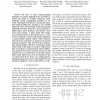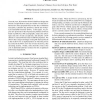54 search results - page 2 / 11 » Oblivious Transfer Based on Physical Unclonable Functions |
SCN
2008
Springer
13 years 9 months ago
2008
Springer
In 2004, Molnar and Wagner introduced a very appealing scheme dedicated to the identification of RFID tags. Their protocol relies on a binary tree of secrets which are shared
ISCAS
2008
IEEE
14 years 3 months ago
2008
IEEE
— The lack of robust tamper-proofing techniques in security applications has provided attackers the ability to virtually circumvent mathematically strong cryptographic primitive...
FPL
2007
Springer
14 years 3 months ago
2007
Springer
In recent years, IP protection of FPGA hardware designs has become a requirement for many IP vendors. To this end solutions have been proposed based on the idea of bitstream encry...
CCS
2010
ACM
13 years 9 months ago
2010
ACM
We show in this paper how several proposed Physical Unclonable Functions (PUFs) can be broken by numerical modeling attacks. Given a set of challenge-response pairs (CRPs) of a PU...
FPL
2011
Springer
12 years 9 months ago
2011
Springer
—On-chip Physical Unclonable Functions (PUFs) are emerging as a powerful security primitive that can potentially solve several security problems. A PUF needs to be robust against...


